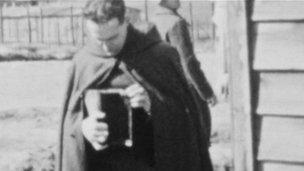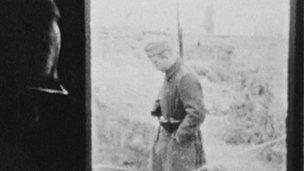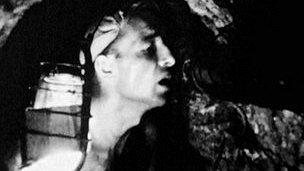How French secretly filmed prison camp life in WWII
- Published
Incredible secret footage filmed inside the Nazi prison camp
One of the most extraordinary episodes involving Allied prisoners during World War II was recently remembered in Paris.
They had been defeated in the Battle of France and marched to the furthest reaches of the Reich. In 1940, Oflag 17a must have felt a bleak, unforgiving place for the 5,000 French officers who were now prisoners-of-war.
The Austrian camp, close to the border with Czechoslovakia, was originally built for troops taking part in military exercises.
There were 40 barracks, 20 each side of a central aisle. The land was bound by two lines of barbed wire, the perimeter illuminated by floodlights.
Escape seemed almost impossible. Almost.... and it is remarkable that we can see it.
Through some extraordinary ingenuity - and cunning - the men filmed their efforts.
Their rarely seen footage is called Sous Le Manteau (Clandestinely). So professional is it that on first viewing you would be forgiven for thinking it is a post-war reconstruction.

Prisoners filmed the camp secretly with a camera inside a hollowed-out dictionary
It is in fact a 30-minute documentary, shot in secret by the prisoners themselves. Risking death, they recorded it on a secret camera built from parts that were smuggled into the camp in sausages.
The prisoners had discovered that German soldiers would only check food sent in by cutting it down the middle. The parts were hidden in the ends.
The camera they built was concealed in a hollowed-out dictionary from the camp library. The spine of the book opened like a shutter. The 8mm reels on which the film was stored were then nailed into the heels of their makeshift shoes.
It gives an incredible insight into living conditions within the camp. The scant food they were given, the searches conducted without warning by the German soldiers. They filmed it all, even the searches, right under the noses of their guards.
Tunnel after tunnel
Lt Jean Cuene-Grandidier was a former inmate, and part of the escape committee. Last month he celebrated his 100th birthday.

The film reveals daily life in the prison camp
"In the early days we tried digging a number of tunnels from the huts in which we were barracked," he said.
"It was viewed as a form of resistance. We were never punished. The Germans seemed to accept it, though it never worked. The distances to the wire were too great. And in any case the guards were clever. They always found the tunnels we started. They were looking for the earth we'd removed."
The film shows the prisoners at work on one of 32 tunnels that were dug during the camp's lifetime.
There was no forced labour and so for large parts of the day the prisoners studied. The teaching was led by senior officers, at the time some of the most intellectual men in France, and such was the high quality of the diplomas they taught that many of the qualifications were recognised after the war by the civilian authorities.
Pierre Waendendries, whose father was also a prisoner in the camp, showed us the plans of the tunnel that did eventually work.
The Germans had allowed the officers to build a theatre - dubbed the Theatre de la Verdure (Greenery Theatre). They decorated it with branches, partially obscuring the view of the guards.
The theatre was between the barracks and the wire, which meant the distance they had to dig was now much shorter.
Vital shovels
The International Red Cross had complained the camp lacked protection against air raids, and so the prisoners were given shovels to dig their own slit trenches.

Escapees waited for hours in the suffocating tunnel
In one, by the theatre, they started the tunnel that would eventually stretch beneath the wire.
"There were mathematicians, geologists, architects," said Pierre.
"They had the expertise they required. The malnourished men dug 90m [295ft] underground - far enough to emerge just metres the other side of the second barbed wire."
Within the camp there was meticulous planning. There was a team to fashion civilian clothes they would wear outside the camp. Others forged the identity papers they would need to evade capture. And this time the earth would be hidden in the seats of their theatre.
By 17 September 1943 the men were finally ready to go. The Germans had cancelled the weekend roll-call. A large group went out on the first night. The disappearance went unnoticed and so the next night another group went too.
"The short length of the tunnel and the number of people inside, meant we had to lie in the foetal position," said Jean.
"There was so little air. Some of the men fainted. We waited almost 10 hours to go, all the time imagining the worst; the German firing squad that would surely be waiting at the end of the tunnel."
But once they had emerged, the prisoners were able to run a short distance to the tree cover that was close. Each was given instructions not to travel together and to travel in different directions.
German invitation

The officers had time to study and be inventive
Some of the first escapees were recaptured and returned to the camp before the escape had even been discovered. In fact, 126 were recaptured within the first week. Only two managed to return to France. And only Jean survives to this day.
To celebrate his 100th birthday last month, the extraordinary survivor was honoured by the city of Paris. He already wears France's highest award - the Legion d'honneur.
In 1943 he found his way to Vienna, where he worked as a nurse in a hospital. He treated German soldiers for venereal disease. Eventually he secured a valuable weekend pass back to Paris.
He travelled by train with German officers - and on the platform in Paris, one of them offered to drive him home, in a staff car!
The homecoming was not enough for Jean. Within weeks he had joined the Resistance.
Oflag 17A was the biggest breakout of World War II, but with implications for all later attempts.
It meant that in 1944, 50 of the 76 Allied airmen who escaped from Stalag Luft III in what is now Poland - we know it as The Great Escape - would be executed on Hitler's orders.
- Published30 April 2013
- Published27 March 2012